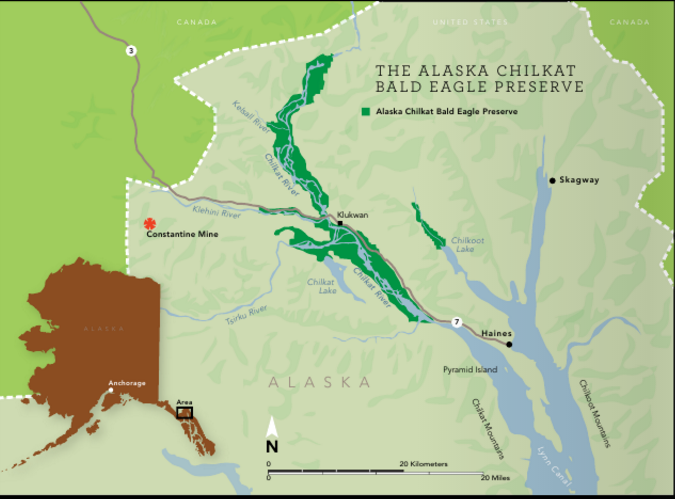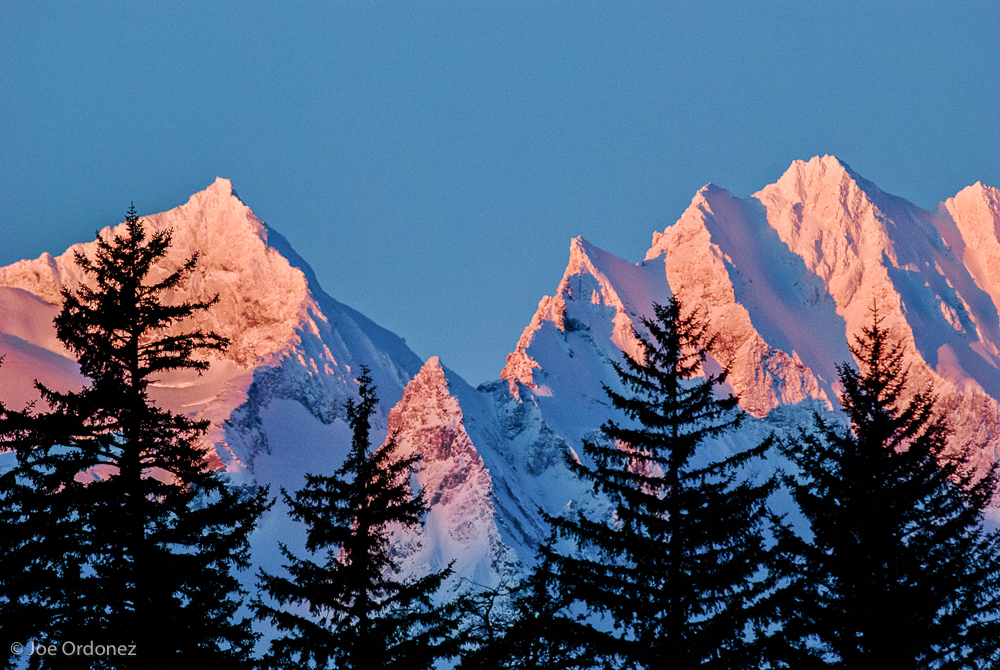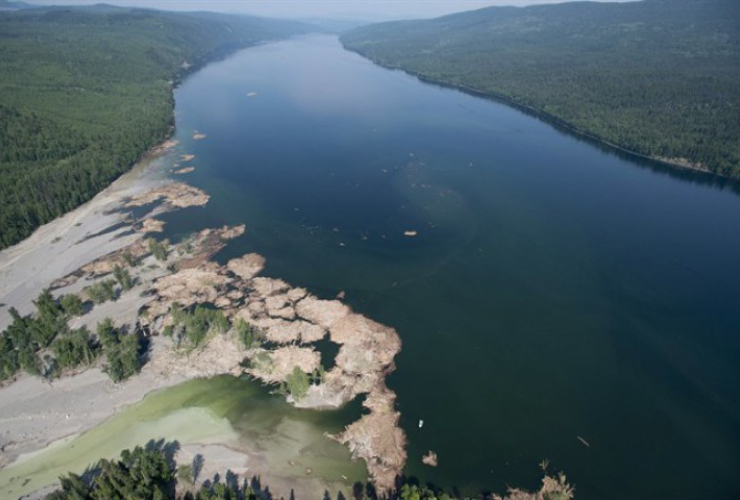Awestruck by the glacier-streaked mountains jutting from the ground and the powerful flowing Chilkat River slicing through the deep valley, Joe Ordonez moved to Haines, Alaska in 1987.
Now, 29 years later, Ordonez is fighting to preserve that same natural grandeur - which includes a world-renowned bald eagle preserve - from a proposed copper, zinc, silver and gold mine upstream.
“It’s a terrible location for a mine,” says Ordonez, who previously worked as a naturalist on cruise ships, work which took him from the Amazon to Antarctica, and who today operates a tour guide company in the region.
“I’ve worked in all seven continents. I’ve seen the most amazing places in the world and here’s one of them right where I live in Haines, Alaska. It’s just not worth the risk. “

Where many see an unspoiled paradise brimming with wildlife, others see money and minerals.
Constantine Metal Resources, a mineral exploration company based in Vancouver, British Columbia, believes the proposed mine location - known as the Palmer Project - is rich in copper and zinc as well as gold and silver.
Backing the penny stock company is Japan’s Dowa Metals and Mining Co, a multinational that is providing Constantine with $22-million in exploration funding over four years in return for a 49 per cent interest in the project.
Executives from Constantine did not return calls from National Observer.
If developed, the mine would sit approximately 60 kilometres upstream from Haines, adjacent to the Klehini River. The Klenhini is a major tributary of the Chilkat.
Not far from the Palmer Project the two rivers merge and at the confluence sits the ancient Tlingit community of Klukwan, whose name translates to mean eternal village.
Ordonez describes the village as one of the longest continually inhabited places in the Americas. “The people there today still catch fish right off their back door and live on it.”
The wild salmon running through the Chilkat don’t just feed the folks in Klukwan and Haines. A combination of natural forces near Klukwan leaves the water ice-free in the winter months, allowing chum salmon to spawn late in the year.
In turn the salmon attract thousands of eagles to feed. The natural phenomenon led to the creation in 1982 of the 48,000 acre Chilkat Bald Eagle Preserve. During the winter over 3,500 bald eagles flock there from as far away as British Columbia, the Yukon and Oregon.
It’s not unusual for tourists to the area to see up to 1,000 eagles at a time.
Ordonez points out that the leading cause of eagle mortality is winter starvation. “So this is a critical area of survival for bald eagles.”

But that could all change if the mine moves ahead.
Ordonez frets that a catastrophic failure, such as that which took place at Mount Polley, might occur.
Described as the worst environmental mining disaster in Canadian history, an estimated 24 million cubic metres of mining waste and water broke free of the Mount Polley mine tailings pond on August 4, 2014.
The mix of toxic metals and water flowed into Hazeltine Creek and then Quesnel Lake, a critical salmon watershed.
The Palmer Project would require a similar kind of tailings pond.
The Chilkat River runs right past Cohen’s front door. Across the way he can hear the roar of the 1,000 foot waterfall that plunges off the glacier on the mountains. “The place is alive with salmon, eagles, bears and moose,” Cohen says.
“The Chilkat River is the heart and soul of this community.”
But Cohen views the mine as a threat to this unspoiled region. “Once they build the tailings pond and they’ve got millions of gallons of waste water held behind an earthen dam, there’s basically a sword hanging over the heads of the community forever, because that tailings pond will have to be maintained in perpetuity.”
Cohen has a Ph.d in environmental policy and specializes in water pollution issues. He points out that it doesn’t even necessarily take a catastrophic spill to end the salmon run.
If any minerals should leach into the Klehini from the mine site and then into the Chilkat, they could cause the salmon to become disoriented and leave them unable to determine where they should properly lay their eggs.
“Then that’s the end of the run,” Cohen says.
“It’s a very fragile system and we’re very concerned that having a large-scale mine in the area would threaten that for many, many years to come.”

For its part, on its website Constantine says, “Not only is protecting the environment, fishery, fauna, and water quality extremely important to Constantine, it is the law.”
The company says it has used a third party since 2008 to collect water quality data in order to establish baseline environmental conditions.
Beyond that, Constantine notes that before it can successfully establish a fully operational mine, “lengthy and detailed studies” will be required on everything from air and water quality to wetlands and wildlife.
They also promise community consultation and socioeconomic studies before the mine gains its permits and begins construction.
The Village of Klukwan isn’t waiting and taking any chances. With help from Cohen, the community has applied to the state to have the Chilkat declared an Outstanding Natural Resource Water, which would give the river protected status.
But the process in Alaska to have a river made into an Outstanding Natural Resource Water doesn’t exist and is holding up the nomination while the state legislature debates how to move ahead.
The nomination has polarized people in Haines, a town of 2,500 containing a mix of fishers, tourism operators, telecommuters, retirees, as well as a number of mine employees and contractors and suppliers.
A Haines Chamber of Commerce survey found that roughly half the chamber’s members oppose the designation.
Constantine notes that it paid out $198,848 in payroll in 2013 to its 10 employees and another $276,110 to contractors and suppliers. And in 2014, the Palmer Project provided nearly $3-million of direct economic benefit to the Alaska economy, including $1.47 million to Haines.

None of that deters either Cohen and Ordonez, who are determined to spread the word of the threat to their beloved wilderness region.
In fact, Cohen calls Constantine’s contributions to the economy “a farce.
“We have an exploratory company based in Canada coming to a small Alaskan town, throwing money at civic causes, showing up at fundraisers, hiring a few locals to do construction and core drilling jobs in the summer and working the PR angles hard to convince people they care about our community.”
Cohen calls the company’s promises and assurances meaningless. He points out that as an exploratory company Constantine will likely have nothing to do with the design and operation of the mine. “They will be off looking for another ore body to develop.”
Cohen says he’s not opposed to mining, but doesn’t believe in placing one in critical fisheries habit.
There’s very few places left in the world that have wild salmon and we’re lucky enough to be one of them.”

Similarly, Ordonez recalls living in Bellingham, Washington where he heard stories about how people “could walk across the river on the backs of the salmon in the old days."
Now he says the state spends millions just to rehabilitate a stream.
“Here we’ve got a place where we don’t have to bring things back because the salmon are there right now.”
Ordonez even wrote a book last year titled Where Eagles Gather in order to bring attention to the eagle preserve and the threat it faces. According to Ordonez, eagles are a symbol of wilderness.
“They are a symbol of something that’s disappearing. We need to gather together and fight this and protect it.”




Comments